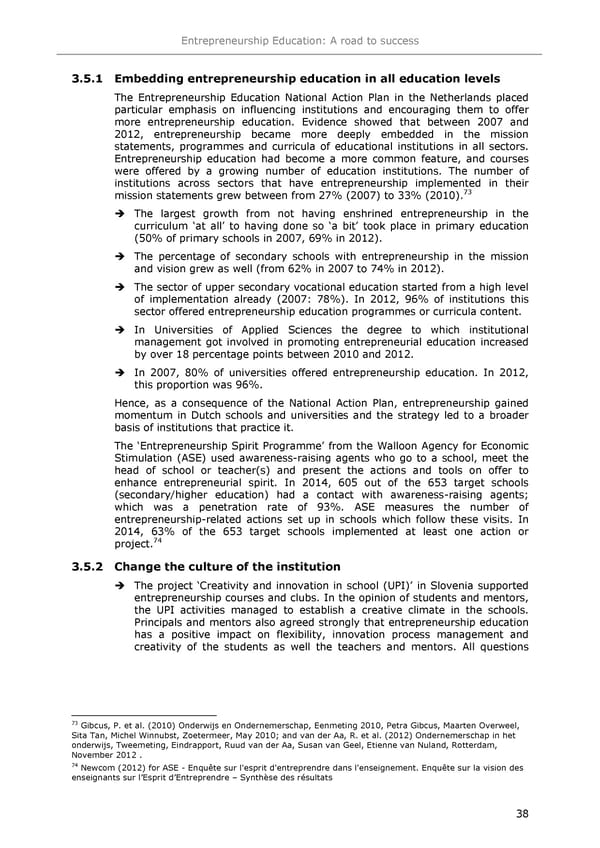Entrepreneurship Education: A road to success 3.5.1 Embedding entrepreneurship education in all education levels The Entrepreneurship Education National Action Plan in the Netherlands placed particular emphasis on influencing institutions and encouraging them to offer more entrepreneurship education. Evidence showed that between 2007 and 2012, entrepreneurship became more deeply embedded in the mission statements, programmes and curricula of educational institutions in all sectors. Entrepreneurship education had become a more common feature, and courses were offered by a growing number of education institutions. The number of institutions across sectors that have entrepreneurship implemented in their 73 mission statements grew between from 27% (2007) to 33% (2010). The largest growth from not having enshrined entrepreneurship in the curriculum 8at all9 to having done so 8a bit9 took place in primary education (50% of primary schools in 2007, 69% in 2012). The percentage of secondary schools with entrepreneurship in the mission and vision grew as well (from 62% in 2007 to 74% in 2012). The sector of upper secondary vocational education started from a high level of implementation already (2007: 78%). In 2012, 96% of institutions this sector offered entrepreneurship education programmes or curricula content. In Universities of Applied Sciences the degree to which institutional management got involved in promoting entrepreneurial education increased by over 18 percentage points between 2010 and 2012. In 2007, 80% of universities offered entrepreneurship education. In 2012, this proportion was 96%. Hence, as a consequence of the National Action Plan, entrepreneurship gained momentum in Dutch schools and universities and the strategy led to a broader basis of institutions that practice it. The 8Entrepreneurship Spirit Programme9 from the Walloon Agency for Economic Stimulation (ASE) used awareness-raising agents who go to a school, meet the head of school or teacher(s) and present the actions and tools on offer to enhance entrepreneurial spirit. In 2014, 605 out of the 653 target schools (secondary/higher education) had a contact with awareness-raising agents; which was a penetration rate of 93%. ASE measures the number of entrepreneurship-related actions set up in schools which follow these visits. In 2014, 63% of the 653 target schools implemented at least one action or project.74 3.5.2 Change the culture of the institution The project 8Creativity and innovation in school (UPI)9 in Slovenia supported entrepreneurship courses and clubs. In the opinion of students and mentors, the UPI activities managed to establish a creative climate in the schools. Principals and mentors also agreed strongly that entrepreneurship education has a positive impact on flexibility, innovation process management and creativity of the students as well the teachers and mentors. All questions 73 Gibcus, P. et al. (2010) Onderwijs en Ondernemerschap, Eenmeting 2010, Petra Gibcus, Maarten Overweel, Sita Tan, Michel Winnubst, Zoetermeer, May 2010; and van der Aa, R. et al. (2012) Ondernemerschap in het onderwijs, Tweemeting, Eindrapport, Ruud van der Aa, Susan van Geel, Etienne van Nuland, Rotterdam, November 2012 . 74 Newcom (2012) for ASE - Enquête sur l'esprit d'entreprendre dans l'enseignement. Enquête sur la vision des enseignants sur l9Esprit d9Entreprendre 3 Synthèse des résultats 38
 Entrepreneurship Education Page 41 Page 43
Entrepreneurship Education Page 41 Page 43